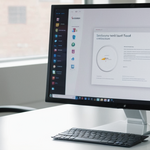
The Capital One data breach of 2019 remains one of the most significant cybersecurity incidents in the financial services industry, affecting approximately 106 million individuals across the United States and Canada with exposure of highly sensitive personal and financial information. This comprehensive analysis examines the breach’s scope, technical nature, methods for determining personal impact, legal settlements, and protective measures available to affected individuals, providing an authoritative guide for understanding this landmark cybersecurity incident and its ongoing implications for consumers.
Understanding the Capital One Data Breach: Scale, Timeline, and Discovery
Overview and Initial Discovery
The Capital One data breach represents a watershed moment in financial cybersecurity, fundamentally altering how institutions approach cloud security and data protection practices. On July 19, 2019, Capital One determined that an unauthorized individual had gained access to sensitive information belonging to approximately 100 million individuals in the United States and approximately 6 million in Canada. However, the actual unauthorized access occurred on March 22 and 23, 2019, meaning the breach went undetected for nearly four months before Capital One’s security team identified the incident. The discovery process itself provides insight into Capital One’s security infrastructure strengths and weaknesses, as the company did not identify the breach through its own internal monitoring systems but rather through its Responsible Disclosure Program, where an external security researcher reported a vulnerability on July 17, 2019. Capital One then began its internal investigation, leading to the formal discovery of the breach just two days later. This timeline demonstrates both the challenges of detecting sophisticated cloud-based intrusions and the value of responsible security research disclosure programs in identifying compromises that might otherwise remain hidden.
The announcement of the breach on July 29, 2019, sent shockwaves through the financial services industry and among the broader population of affected consumers. Capital One’s shares closed down 5.9% immediately upon announcement, ultimately losing 15% of their value over the subsequent two weeks. The financial impact extended beyond stock price depreciation, as Capital One estimated the incident would cost between $100 million and $150 million in 2019 alone for customer notifications, credit monitoring, technology remediation, and legal support. A class action lawsuit was filed within days of the public disclosure, acknowledging the magnitude of harm caused to affected individuals and the bank’s responsibility for safeguarding customer data.
Perpetrator and Criminal Case
The breach was perpetrated by Paige A. Thompson, a 33-year-old former Amazon Web Services engineer, who was arrested by the FBI on July 29, 2019, and charged with wire fraud and computer intrusions. Thompson’s background in cloud computing and her previous employment at Amazon, which hosts Capital One’s infrastructure, provided her with sophisticated knowledge of AWS systems, security vulnerabilities, and network architecture. According to the FBI complaint and subsequent court documents, Thompson used her technical expertise to create scanning software that identified cloud computing servers with misconfigured firewalls, allowing her to execute commands from outside to penetrate and access these servers. Federal prosecutors alleged that Thompson engaged in a pattern of cyberattacks against multiple organizations beyond Capital One, targeting more than 30 companies including an unnamed state agency, telecommunications companies, and a public research university.
Thompson’s conduct after the breach demonstrated unusual transparency regarding her criminal activity, as she posted details about her exploits on GitHub, creating a public record of her methods and targets. Under the Twitter handle “Erratic,” Thompson shared technical information about how she had executed her attacks, essentially publicizing her crimes in ways that facilitated her identification and arrest. The Department of Justice noted that Thompson embedded cryptocurrency mining software on servers she accessed, directing mining income to her online wallet, demonstrating financial motivation beyond simple data exfiltration. In her original 2022 sentencing, Thompson received a sentence of time served with five years of supervised release, three years of home confinement, and 250 hours of community service, along with a $40.7 million restitution order. However, federal prosecutors appealed this sentence as too lenient, leading to a resentencing in 2024 where U.S. District Judge Robert Lasnik reimposed the original sentence while acknowledging concerns about Thompson’s mental health challenges, gender transition circumstances, and the adequacy of incarceration as punishment.
Technical Analysis: How the Breach Occurred
Cloud Infrastructure Vulnerabilities
The Capital One breach stands as a particularly illuminating case study in cybersecurity because, despite Capital One’s sophisticated cloud infrastructure and early adoption of Amazon Web Services, well-understood and preventable security vulnerabilities enabled the compromise. Capital One had invested heavily in cloud infrastructure and was widely regarded as one of the most cloud-savvy enterprises at the time, serving as an early and vocal advocate for AWS that other organizations sought to emulate. Yet the breach exploited not sophisticated zero-day vulnerabilities or novel attack techniques, but rather a combination of misconfigured cloud resources and insufficient access controls that security experts had long identified as risky.
The attack occurred through a misconfigured firewall deployed by Capital One to protect its AWS infrastructure, specifically a Web Application Firewall (WAF) that was intended to defend against unauthorized access but instead became the pathway for the breach. According to the FBI complaint filed in the U.S. District Court for the Western District of Washington, “A firewall misconfiguration permitted commands to reach and be executed by that server, which enabled access to folders or buckets.” This misconfiguration allowed Thompson to discover vulnerable entry points into the Capital One AWS environment despite the company’s substantial investments in security tools and practices.
Attack Methodology and Data Exfiltration
Once Thompson gained initial access through the misconfigured firewall, she exploited the principle of least privilege violation, whereby the WAF possessed excessive permissions that exceeded what was necessary for its operational role. The WAF had been granted the ability to enumerate and read all files stored in Capital One’s cloud storage buckets, meaning that anyone who gained access to the WAF possessed the same permissions to access an entire database of sensitive information. After gaining access to an Amazon Elastic Compute Cloud (EC2) instance hosting the WAF, Thompson leveraged a Server-Side Request Forgery (SSRF) attack to relay requests to the AWS metadata service, which returned information about the Identity and Access Management (IAM) role attached to the EC2 instance, along with temporary credentials (access token) for that role.
The FBI investigation identified a script hosted on a GitHub repository that Thompson deployed to access Capital One’s data stored in Amazon S3 buckets, consisting of three specific commands that automated the breach process. The first command obtained security credentials necessary to access Capital One’s data folders and buckets, the second command listed the names of folders or buckets within Capital One’s storage space, and the third command copied data from these folders and buckets to Thompson’s own storage location. The FBI confirmed that Capital One’s computer logs documented the execution of these commands, providing an electronic record of exactly when and how the data exfiltration occurred. Through this automated process, Thompson gained access to more than 700 folders or buckets of data, from which she systematically extracted sensitive customer information.
Scale and Scope: Who Was Affected by the Breach
Geographic and Demographic Impact
The breach’s impact extended across North America, affecting millions of individuals in both the United States and Canada who had applied for or held Capital One credit card products. Approximately 100 million individuals in the United States were impacted, while approximately 6 million Canadian consumers experienced unauthorized access to their personal information. In Canada specifically, approximately 1 million Social Insurance Numbers were compromised, representing a significant portion of the Canadian population’s most sensitive identification information. These figures make the Capital One breach comparable in scope to the Equifax breach of 2017, which affected approximately 147 million consumers and resulted in substantial regulatory penalties and consumer compensation.
The affected population included both individual consumers who held Capital One credit cards and small business owners who had applied for Capital One business credit products. Capital One’s records indicated that the largest category of compromised information came from credit card applications filed between 2005 and early 2019, meaning individuals who had applied for Capital One credit card products at any point during this fourteen-year window were potentially affected. This extended timeframe reflects both the historical nature of the data stored in Capital One’s systems and the scope of the breach, as Thompson gained access to accumulated years of customer application data. Importantly, Capital One clarified that customers from the company’s Auto Finance, Commercial Bank, and UK card businesses were not impacted by the breach, indicating that the compromise affected primarily the credit card division’s customer base.

Types of Information Compromised
The breach exposed multiple categories of sensitive personal and financial information, ranging from basic contact details to highly sensitive financial identifiers. For credit card applicants and customers, Capital One disclosed that the unauthorized access included the following information: personal information routinely collected at the time of credit card applications including names, addresses, zip codes/postal codes, phone numbers, email addresses, dates of birth, and self-reported income. For credit card customers specifically, the attacker obtained portions of credit card customer data including customer status information such as credit scores, credit limits, account balances, and payment history, along with contact information.
Most concerning was the exposure of highly sensitive government identification numbers and financial account information. Approximately 140,000 Social Security numbers belonging to credit card customers in the United States were compromised. Additionally, approximately 80,000 linked bank account numbers of secured credit card customers were exposed. For Canadian customers, approximately 1 million Social Insurance Numbers were compromised, representing a substantial portion of the breached Canadian data. Capital One emphasized that importantly, no credit card account numbers or log-in credentials were compromised, and less than one percent of Social Security numbers were compromised overall, though the absolute numbers affected remained significant.
In a subsequent discovery in January 2021, Capital One’s ongoing analysis of the files stolen revealed that approximately 4,700 U.S. credit card customers or applicants whose Social Security Numbers had been among the data accessed had not been previously identified. The company directly notified these additional affected individuals and made two years of free credit monitoring and identity protection available at no cost to them, demonstrating the complexity of fully understanding the breach’s scope in its immediate aftermath.
Determining Personal Impact: How to Know If You Were Affected
Official Notification Methods
Capital One implemented a multi-channel notification strategy to inform affected individuals of their exposure in the breach, though the company acknowledged that not all affected consumers had been immediately identified. The company stated that it would “notify affected individuals through a variety of channels,” but clarified that the primary notification method for individuals whose most sensitive information was compromised was direct mail notification to their last known address. Specifically, Capital One committed to directly notifying by mail all U.S. individuals whose Social Security numbers or linked bank account numbers were accessed, and to notify all Canadian customers affected by the breach.
Capital One advised that individuals who received notification letters indicating that their Social Security numbers or bank account numbers were among the data accessed should take the notification seriously and consider themselves confirmed members of the affected population. However, the company noted that the notification process would occur in waves, with notifications expected to begin in the week following the July 29, 2019 public announcement and continuing over subsequent weeks. For individuals who did not receive formal notification but had concerns about potential exposure, Capital One suggested reviewing their Capital One account online or contacting the company directly to inquire about their status, though Capital One did not provide a simple mechanism for all individuals to verify their inclusion in the breach.
Eligibility and High-Risk Population
Capital One clarified that individuals who were most likely to have been affected were those who had applied for a Capital One credit card product at any point between 2005 and early 2019. This designation encompassed a vast population given the timeframe involved, as it included anyone who had submitted a credit card application during this fourteen-year period, regardless of whether the application was approved. Additionally, individuals who held Capital One credit cards at the time of the breach in March 2019 were also affected, as their customer status data, transaction information, and in some cases identification numbers were exposed.
Notably, individuals who received no direct notification but had unexplained suspicious activity on their credit cards or discovered fraudulent accounts opened in their name should consider themselves potentially affected by the breach, even if Capital One did not send official notification. The company advised that the absence of notification did not necessarily mean an individual was unaffected, as the complexity of identifying all affected individuals and the subsequent January 2021 discovery of an additional 4,700 individuals demonstrated that Capital One’s initial assessment was incomplete.
Self-Assessment and Verification Approaches
For individuals uncertain about their exposure, Capital One and the Identity Theft Resource Center recommended several verification approaches. Individuals who remained concerned about potential exposure despite not receiving direct notification were advised to monitor their credit reports with the three major credit reporting agencies—Equifax, Experian, and TransUnion—for signs of unauthorized activity or fraudulent accounts. The company encouraged all individuals, whether affected by the breach or not, to request a free copy of their credit report once every twelve months from each of the three national credit reporting agencies, which can be obtained through the Annual Credit Report Request Service at www.annualcreditreport.com or by calling 1-877-322-8228.
Individuals could also contact Capital One directly through customer service channels to inquire about their breach status, either through the toll-free number on the back of their Capital One card or statement or through Capital One’s online banking portal. For those who accessed Capital One online banking, the company indicated that notifications and information about the breach would be available through their account dashboard. Additionally, Capital One advised individuals to be cautious of fraudulent communications claiming to be from Capital One, as scammers frequently exploit data breach incidents to perpetrate additional fraud through phishing emails, text messages, and phone calls. The company emphasized that Capital One would not proactively call or email customers asking for account information, Social Security numbers, or financial details related to the breach.
Legal Settlements and Compensation: Financial Remedies for Affected Individuals
The Primary Settlement: $190 Million Resolution
In response to class action litigation filed by affected consumers, Capital One agreed to a landmark $190 million settlement to resolve claims arising from the 2019 data breach. On February 7, 2022, a U.S. federal court preliminarily approved the class action settlement, with final approval granted on September 13, 2022, resolving the consolidated multidistrict litigation titled “In re: Capital One Customer Data Security Breach Litigation,” Case No. 1:19-md-2915 in the U.S. District Court for the Eastern District of Virginia, Alexandria Division. The settlement established a compensation fund allowing class members to seek reimbursement for losses directly attributable to the data breach, with the settlement covering approximately 98 million affected consumers and small business owners.
The settlement’s monetary component allowed class members to collect cash payments for out-of-pocket expenses and lost time directly related to the breach. Eligible individuals could seek reimbursement of up to $25,000 for documented losses including fraudulent charges not covered by their financial institutions, expenses incurred preventing identity theft or fraud, payments for credit monitoring or identity protection services, professional fees such as attorney or accountant fees, and up to 15 hours of lost time at a rate of at least $25 per hour. Documentation requirements were strict, requiring detailed proof including bank statements, receipts, invoices, credit reports, medical records if applicable, and detailed narrative descriptions of how expenses were directly attributable to the breach.
The claim filing period for monetary compensation closed on September 30, 2022, and payment distributions were completed between 2022 and 2023, with the settlement administrator reporting that affected consumers received payments ranging from less than $1 to over $2,000 depending on their documented losses, with subsequent payment rounds in 2023 and 2024 bringing some individuals additional compensation. According to reports from Top Class Actions, individuals received payments of approximately $2,128.35 in some cases by October 2023, with additional payments of approximately $34.22 reported in subsequent rounds as of September 2024, representing continued distribution of settlement funds.
Ongoing Identity Protection Services
Beyond the monetary settlement fund, Capital One committed to providing comprehensive identity protection services to all affected individuals through a comprehensive remediation program. The settlement established three years of identity defense services provided by Pango Group at no cost to settlement class members through February 13, 2028, though the deadline to claim these services had passed in 2022 for maximum coverage duration. Settlement class members who had submitted claims to enroll in identity defense services by September 30, 2022, were eligible for the maximum of five years of services through February 13, 2028, while those who enrolled later could access services up to the February 13, 2028 termination date.
The identity defense services included comprehensive features such as dark web monitoring for Social Security numbers, dates of birth, addresses, driver’s license numbers, passport numbers, payment cards, email addresses, and other personal information; identity monitoring with authentication alerts; lost wallet protection; security freeze capabilities with major credit reporting agencies (Experian, Equifax, TransUnion, and Innovis) and specialty finance agencies; and access to fraud resolution specialists for account restoration services. Settlement class members also received $1 million in no-deductible insurance provided by a third-party insurer to cover certain costs related to identity theft or fraud, and access to U.S.-based customer support specially trained in identity theft and fraud discovery and remediation.
All settlement class members, regardless of whether they enrolled in identity defense services or submitted claims, were entitled to free restoration services offered through Pango until February 13, 2028, providing access to U.S.-based fraud resolution specialists who could assist with placing fraud alerts with credit bureaus, disputing inaccurate information on credit reports, scheduling calls with creditors and service providers, and working with law enforcement and government agencies to address fraudulent information. These restoration services could be accessed by calling 505-896-7416 or through the online portal at identitydefense.com, allowing affected individuals to obtain assistance with fraud remediation at no cost.

Additional Settlement: $425 Million for 360 Savings Account Interest Rate Violations
Independent of the data breach settlement, Capital One reached a separate $425 million class action settlement in 2025 regarding its 360 Savings accounts, which affected a different population of customers but demonstrated Capital One’s broader compliance challenges. This settlement, still pending final court approval as of November 6, 2025, addresses allegations that Capital One deceptively marketed its 360 Savings account as a high-yield savings product while later creating a nearly identical 360 Performance Savings account with substantially higher interest rates, then failing to notify existing 360 Savings accountholders about the superior product. While this settlement is distinct from the data breach, Capital One customers who held a 360 Savings account between September 18, 2019, and June 16, 2025, are eligible for $300 million in cash payments based on the interest differential between the two accounts during the relevant period, with an additional $125 million allocated for future interest rate adjustments for customers maintaining open accounts.
Protective Measures and Remediation: Post-Breach Actions for Affected Individuals
Immediate Actions to Take
The Identity Theft Resource Center and Capital One recommended that individuals affected by or concerned about the data breach take immediate protective steps to mitigate identity theft risk. First, individuals whose Social Security numbers were compromised should consider placing a fraud alert on their credit reports by contacting any one of the three nationwide credit bureaus (Equifax, Experian, or TransUnion) at their toll-free fraud hotlines. An initial fraud alert stays on a credit report for one year and acts as an alert to potential lenders that the individual’s identity may have been compromised, requiring verification before opening new accounts. For individuals who had become victims of identity theft, an extended fraud alert could be placed on their credit report for seven years, providing longer-term protection.
More comprehensive than fraud alerts, credit freezes restrict access to credit reports, preventing unauthorized parties from opening accounts in the victim’s name without explicit authorization from the account holder. Individuals could place credit freezes with Equifax, Experian, and TransUnion to prevent the use of their compromised information for fraudulent credit applications. The process of placing a freeze requires contacting each agency directly and following their verification procedures, but once in place, credit freezes provide substantial protection against the most common forms of identity theft resulting from data breaches.
Beyond credit protection, affected individuals should have monitored their existing financial accounts carefully for suspicious activity and changed passwords for all financial accounts, particularly Capital One accounts. Cybersecurity experts recommend using complex passwords that are difficult to guess, containing a series of letters, numbers, and symbols, and not repeating passwords across multiple accounts. Individuals should also consider changing passwords for email and other online accounts associated with their compromised information, as attackers who possess an individual’s email address and other identifying information can use those credentials to compromise additional accounts and perpetrate further fraud.
Ongoing Monitoring and Detection Services
Capital One and the settlement provided comprehensive ongoing monitoring services to help affected individuals detect unauthorized use of their compromised information. The company’s CreditWise service offers free credit score monitoring, credit report access, and dark web monitoring to all individuals, including those who did not suffer harm in the breach but want to monitor for future threats. CreditWise scans the dark web for stolen personal data, including Social Security numbers, passwords, email addresses, bank account numbers, and login credentials, and sends alerts if any of the monitored information is discovered on illicit marketplaces.
Individuals with Capital One settlement status were encouraged to enroll in the identity defense services provided through Pango before the February 13, 2028 termination date to maximize the protection offered by the settlement. These services included automatic dark web monitoring and alerts, allowing individuals to know immediately if their information appeared in breached databases or on criminal marketplaces. Settlement class members could also access identity monitoring with authentication alerts through the settlement services, receiving notifications when changes were made to credit profiles, new accounts were opened, or other suspicious activity occurred.
Capital One’s Security Enhancements
In response to the breach and its aftermath, Capital One committed to extensive cybersecurity improvements and investments designed to prevent similar incidents. The company’s board and leadership made a commitment to incorporate learnings from the breach to strengthen cyber defenses and invested substantially in enhanced security infrastructure. Capital One implemented sophisticated fraud detection systems designed to detect unusual activity and protect customers from unauthorized actions. The company enhanced its monitoring capabilities and security protocols, particularly related to cloud infrastructure configurations and access controls that had been exploited in the breach.
Capital One also enhanced customer-facing security features, including account alerts that customers could configure through online banking to receive text or email notifications about account activity. Customers were encouraged to sign in to their online banking platforms and set up alerts based on their preferences, allowing them to immediately detect suspicious transactions or unauthorized access attempts. Additionally, Capital One offered mobile app verification, where customers could approve login attempts through push notifications sent to their phones, adding an additional layer of authentication to prevent unauthorized account access.
Broader Implications and Lessons from the Capital One Breach
Why a Well-Protected Institution Was Compromised
The Capital One breach provides crucial lessons about the limitations of even sophisticated security infrastructure when proper security controls and monitoring are not implemented comprehensively. Capital One had invested heavily in cloud infrastructure and encryption, was regarded as one of the most cloud-savvy enterprises at the time, and had transitioned to AWS in ways that other organizations sought to emulate as a best practice example. Yet the breach revealed that strong foundational infrastructure means little without proper configuration, access controls, and continuous monitoring of security systems.
The breach stemmed not from innovative zero-day exploits or previously unknown vulnerabilities, but rather from well-understood security configuration failures and insufficient monitoring. Specifically, the misconfigured Web Application Firewall, excessive IAM permissions granted to the firewall, and the lack of adequate intrusion detection and monitoring allowed the attack to proceed undetected for months despite consuming resources at scale. This pattern demonstrates that cybersecurity excellence requires not only deploying sophisticated tools but also properly configuring them according to security best practices, continuously monitoring their operation, and maintaining organizational discipline around access control principles.
Industry-Wide Impact and Regulatory Response
The Capital One breach accelerated industry awareness of cloud security misconfiguration risks and prompted regulatory scrutiny of financial institution cybersecurity practices. The Office of the Comptroller of the Currency (OCC) launched a comprehensive review of Capital One’s cybersecurity practices and assessed regulatory penalties against the institution, imposing substantial fines related to inadequate security controls that enabled the breach. This regulatory response signaled to the entire financial services industry that institutions would face consequences not only for the fact of breaches occurring but also for failing to maintain adequate control frameworks to prevent known vulnerabilities from being exploited.
The breach also contributed to ongoing discussions about data protection regulations and cybersecurity standards, informing the development of frameworks like the National Institute of Standards and Technology (NIST) Cybersecurity Framework, which is widely used by government agencies and companies to provide cyber threat mitigation guidelines. Academic analyses of the breach examined the incident through the lens of compliance requirements and identified gaps between existing regulatory expectations and the technical controls actually in place at even well-resourced financial institutions.
Bringing It All Together: Your Capital One Breach Impact
As of November 2025, the Capital One data breach remains one of the most significant financial services cybersecurity incidents in recent history, with lasting implications for affected consumers and the broader industry. While the primary settlement’s claim filing period closed in 2022 and monetary distributions have been completed, affected individuals continue to have access to identity defense and restoration services through February 13, 2028, providing long-term protection against identity theft and fraud resulting from the breach. The broader financial services industry has implemented enhanced cloud security practices, improved access controls, and invested substantially in monitoring capabilities designed to prevent similar misconfiguration vulnerabilities from enabling future breaches.
For individuals attempting to determine whether they were affected by the Capital One breach, the most reliable approach is to review any official notification letters sent by Capital One to their last known address, particularly if they received confirmation that their Social Security number or bank account information was compromised. Those who did not receive official notification but applied for Capital One credit card products between 2005 and early 2019 should consider themselves potentially affected and take protective measures including credit monitoring, fraud alerts, and password changes. Affected individuals should remain alert for phishing attempts and fraudulent communications exploiting the breach and should consider enrolling in available identity defense services, particularly before the February 13, 2028 termination date for settlement-provided protections. The Capital One breach ultimately serves as a reminder that comprehensive cybersecurity requires not only deploying sophisticated technology but also implementing proper configuration practices, maintaining vigilant monitoring, and sustaining organizational commitment to security principles at the highest levels of institution governance.
Protect Your Digital Life with Activate Security
Get 14 powerful security tools in one comprehensive suite. VPN, antivirus, password manager, dark web monitoring, and more.
Get Protected Now





